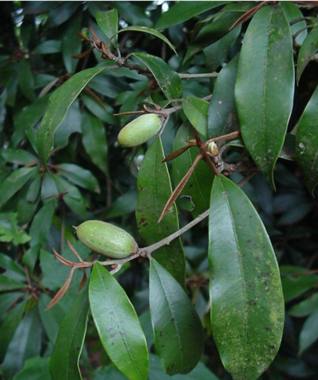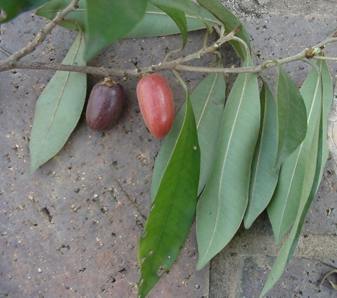Englerophytum natalense
Englerophytum natalense (Sond.) T.D.Penn. [= Bequaertiodendron natalense]
Family: Sapotaceae
Common names: Natal or silverleaf milkplum (Eng.); Natalmelkpruim (Afr.); umThongwane (isiZulu, isiXhosa); ithunga, umThungwane (isiXhosa); umTjongane (isiSwati)
SA Tree No: 582
Introduction
An attractive garden plant, a tree with edible fruit and white-to-cream flowers.
Description
Description
Medium to large evergreen tree, latex milky. Bark smooth, grey and brown. Stem straight branching horizontally. Young branches with dense brownish hairs. Leaves alternate or spiralled, crowded toward branchlet ends, leathery, glossy greyish green and hairless above, under surface densely covered with silvery hairs often tinged with brown, usually with pointed tips, tightly folded upward along the midrib when young, margin slightly wavy. Flowers white to cream, about 5 mm long, without stalks, solitary or in groups of 2 or 3 in the axils of the leaves (Nov.-Mar.). Fruit a red acorn-shaped berry.

A related and similar speciesEnglerophytum magalismontanum [= Bequaertiodendron magalismontanum ], a small to medium-sized evergreen tree, has elliptic to narrowly obovate, dark green leaves usually densely covered with reddish brown to silvery hairs below and with rounded tips, and with flowers usually on short stalks and in compact clusters on young and old wood. Manilkara discolor can be confused with E. natalense but it is usually a bigger tree with rough bark, often growing in drier situations, and its leaf tips are usually more rounded.
Conservation Status
Status
Englerophytum natalense is not listed on the Tree Species Protected List in terms of National Forest Act 84 of 1998. In the Red Data List, this taxon was not selected in any one of four screening processes for highlighting potential taxa of conservation concern for detailed assessment and was hence given an automated status of Least Concern.
Distribution and habitat
Distribution description
Englerophytum natalense occurs from the Eastern Cape northwards through KwaZulu-Natal and Swaziland, with isolated populations in Mpumalanga, eastern Zimbabwe and East Africa. It occurs in forest, particularly in subtropical areas, often in groves. In the understorey of dry riverine forest below the mistbelt, in mixed evergreen forest, ravine forest, coastal forest, often in groves, at forest margins, in clearings and in Afromontane forest.
Derivation of name and historical aspects
History
Englerophytum meaning Engler's tree, after Prof. H.G.A. Engler [1844-1930], a German botanist and renowned authority on African plants; natalense from Natal, now KwaZulu-Natal (KZN).
Ecology
Ecology
This plant provides food for the larvae of butterflies Euptera pluto kinugnana, Pseudacraea boisduvalii trimeni, P.eurytus imitator and P. lucretia . Fruits eaten by people, monkeys and birds. Sunbirds feed on flowers.

Uses
Use
An attractive garden plant. Timber is of a good quality, strong and durable; it is used for hut building, and is suitable for fencing poles, implement handles, milking buckets and general carpentry. Good shade and container plant.

Growing Englerophytum natalense
Grow
Grow it from seed. As a garden species this is an ideal small tree that will grow in partial to deep shade. It will not take any frost and is fairly slow-growing. However, the slowness must not discourage you from using this species. A 4 m tall tree can begin fruiting after about its sixth season. As a landscape feature use this species in groves or as a single accent specimen. Seed cleaned of its flesh will germinate fairly quickly in about two to three weeks after sowing. Pot them up into their own individual growing bags and wait for a few years. The plants respond well to feed and will grow well if given enough water, heat and food.
References
- Boon, R. 2010. Pooley's Trees of eastern South Africa: A complete guide , edn 2. Flora & Fauna Publication Trust, Durban.
- Coates Palgrave, M. 2002. Keith Coates Palgrave Trees of southern Africa , edn 3. Struik, Cape Town.
- Nichols, G. 2005. Growing rare plants. A practical handbook on propagating the threatened plants of southern Africa. Southern African Botanical Diversity Network Report No. 36. SABONET, Pretoria.
- Raimondo, D., Von Staden, L., Foden, W., Victor, J.E., Helme, N.A., Turner, R.C., Kamundi, D.A. & Manyama, P.A. (eds) 2009. Red List of South African plants 2009. Strelitzia 25. South African National Biodiversity Institute, Pretoria.
- Schmidt, E., Lötter, M. & McCleland, W. 2002. Trees and shrubs of Mpumalanga and Kruger National Park. Jacana, Johannesburg.
- Van Wyk, B. [A.E.] & Van Wyk, P. 1997. Field guide to trees of southern Africa. Struik, Cape Town.
- Van Wyk, B. [A.E.], Van Wyk, P. & Van Wyk, B-E. 2000. Photographic guide to trees of southern Africa . Briza Publications, Pretoria .
Credits
Frank Nonyane
Pretoria National Herbarium
February 2013
Plant Attributes:
Plant Type: Tree
SA Distribution: Eastern Cape, KwaZulu-Natal, Mpumalanga
Soil type:
Flowering season: Early Summer, Late Summer
PH:
Flower colour: White, Cream
Aspect: Shade
Gardening skill: Easy
Special Features:
Horticultural zones









Rate this article
Article well written and informative
Rate this plant
Is this an interesting plant?
Login to add your Comment
Back to topNot registered yet? Click here to register.